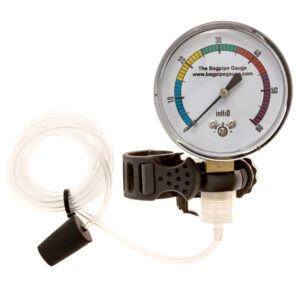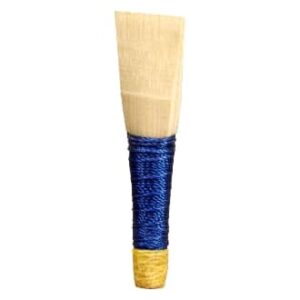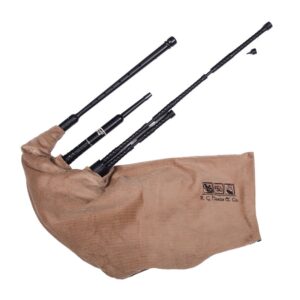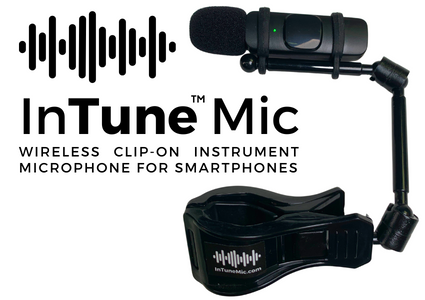
AS FEATURED IN

Answers to Frequently Asked Questions
by Jori Chisholm, Founder of BagpipeLessons.com
Last Updated: July 17, 2025
Is it difficult to learn to play bagpipes?
- Learning to play the bagpipes can be challenging, but with the right guidance and resources from BagpipeLessons.com, it is achievable for anyone. We offer high-quality online lessons and resources suitable for both beginners and advanced players.
- With regular practice you can progress from a practice chanter onto pipes, which can take another several months or years to become competent.
How long does it take to learn the bagpipes?
- The time to learn the bagpipes varies based on individual dedication and practice. With regular practice, most people can transition from the practice chanter to the full bagpipes in 6-12 months. Mastering the instrument typically takes several years of dedicated practice.
- You will start your piping journey with a practice chanter to learn the fingering and basic gracenotes without the loud volumes of the highland pipes.
- Bands, teachers, and experienced competitors continue to use the practice chanter for the rest of their lives on a daily basis. This is because you can practice the fingering and melody without the volume. The practice chanter makes it easier to start and stop so you can focus on the parts of your tunes that need more focused practice.
- After you learn the basic embellishments and memorize a handful of tunes, you should be ready to move to the highland pipes. Reaching this point can take anywhere from six months to more than two years.
Am I too old to learn bagpipes?
- No, you are never too old to learn the bagpipes. BagpipeLessons.com welcomes students of all ages, including older beginners.
Do you need to be able to read music to play bagpipes?
- Reading music is not required to start learning the bagpipes. BagpipeLessons.com offers lessons that cater to various learning styles, including for those not familiar with reading music.
Do you have any recommendations for memorizing new tunes?
- Many pipers struggle with memorization even after years of playing. Here are six techniques that can help:
1. Chunk the tune into small phrases and memorize each one individually. This makes it easier to recall and reduces the overwhelming feeling.
2. Visualize the music away from your chanter—mentally picture the notes, finger positions, and rhythms.
3. Sing the tune in rhythm, without playing. This strengthens mental recall and internal timing.
4. Link sections together gradually, overlapping the end of one phrase with the beginning of the next to build fluency.
5. Test your memory early and often by trying to recall a section without looking at the music, even before you feel ready.
6. Practice from different starting points within the tune. This builds flexible recall and helps avoid getting lost under pressure.
What is a practice chanter?
- A practice chanter is a fundamental piece of equipment that every piper needs through all stages of their career. With a practice chanter, you will learn to play the basic technique, notes and tunes that you’ll need to play the bagpipes.
- Using the Chanter as a Practice Chanter: A pipe chanter works with the pipes but not as a practice chanter. While the fingering is the same, the pipe chanter takes a different reed, is much louder, and harder to blow. The practice chanter, on the other hand, is comfortable to blow, quieter, and softer. I recommend one of these practice chanters.
What’s the difference between a “practice chanter” and a “normal” chanter? 
- The internal dimensions and size of finger holes of a practice chanter, combined with a low pressure reed make for a quieter, more forgiving instrument.
- After getting a handle on finger technique and being able to play a half-dozen or so tunes from memory is when a learner usually starts to learn to blow the pipes.
- No matter how long they have been playing, pipers still use the practice chanter to learn tunes and work on technique.
What types of lessons do you offer?
- We offer a range of lessons including individual lessons, group workshops, and online courses. There are options for pipers of all levels, from beginners to advanced players.
Can I get personalized feedback on my playing?
- Yes, one-on-one lessons provide personalized feedback from experienced instructor Jori Chisholm, the founder of BagpipeLessons.com.
Are there resources available for advanced players?
- Absolutely, we offer resources and lessons for advanced players looking to improve their skills and performance.
Is there a community or support group for learners?
- Yes, our Inner Circle Membership offers access to a community of pipers where members can share experiences, get support, and access exclusive content.
Can online lessons replace in-person instruction?
- Since the advent of “remote learning” during the pandemic, the answer to this question has changed. Many people feel that one-on-one online lessons are now equivalent to in-person lessons, and some prefer that option.
- If you find an instructor who lives a reasonable distance away, it is worthwhile to do a monthly visit for in-person playing as the two experiences are drastically different.
Do I have to be in-shape to play the bagpipes?
- Bagpipes are one of the most difficult instruments in the world. Apart from the complicated finger technique required to play, there are unique physical demands on pipers to play the instrument well. Playing the bagpipes is like a full time gym membership, but instead of counting reps, you’ll be counting minutes.
- Weight Lifting: Bagpipes weigh about 5 to 6 pounds, and they can feel incredibly heavy after a 30 or 60 minute practice session. The beginning stages will be the hardest. You may begin to experience light-headedness after a few minutes of blowing, but with practice, this will go away. Headaches can occur, but staying hydrated will aid your short term endurance.
- Arm Muscles: Y will be using muscles in your arm that have never been used in this way before, so you may experience soreness in the arm that is used to squeeze the bag.
- Hand Muscles: Dexterity and speed required for bagpiping will require finger strength.
- Lip Muscles: Your lips will be tired at first, but this should go away if practice is steady and consistent.
- Ear Muscles: Wear ear protection as repeated exposure to loud volumes will result in deafness over time.
I’m worried about the volume, what are your thoughts? What is the best way to practice bagpipes without disturbing my neighbors?
- Bagpipes are made to be played outdoors and practicing in a modern urban environment might prove difficult.
- One solo bagpipe can be as loud as a lawnmower, while a full pipe band can be as loud as a jet engine taking off.
- The pipes carry over a great distance due to piercing pitch and volume. Think carefully about where to practice, as many public places have noise ordinances.
- In my experience, you just have to give it a try and cooperate with your neighbors. Use common sense, kindness and understanding, and you can’t go wrong.
Will a small bagpipe bag make it easier to maintain necessary pressure?
- A smaller bag can help maintain a more consistent pressure when playing and marching, as it makes it easier to control and keep the pipes up high under your arm for better leverage.
How do you determine what size tap to use to thread drone reeds so they seat properly?
- Regarding seating your drone reeds, using the correct tap is key for a secure fit. I rely on a trusted set of metric taps from Craftsman.
- For most tenor drone reed seats, I recommend a Metric Tap M10 x 1.25mm.
- For most bass drone reed seats, the Metric Tap M11 x 1.5mm works best.
- Additionally, an adjustable tap wrench handle for taps sized M1-M12 can be very useful.
Do you have any ergonomic accessories to help with playing comfort for older pipers?
- Yes, I invented the The Perfect Angle™ Blowpipe Positioner for this exact reason. This tool keeps your blowpipe at the best spot for ideal posture, optimal ergonomics, greatest stamina and most overall comfort. It makes a dramatic improvement that you will notice immediately.
- If you have product ideas to make your playing experience more enjoyable, please share them with me!
What’s your return policy? What can I do if the product doesn’t work for me?
We are confident in the quality and effectiveness of our products. If for any reason you find that our products do not meet your expectations or help you achieve your goals, we offer a full refund.
In the unlikely case that you receive a defective product, we will replace it.
Products in original condition can be returned in original packaging at the customer’s cost.
Please contact us to arrange return shipping. Once the returned product is returned, we can provide a refund or store credit to the customer. All refunds incur a 4% restocking fee. This is due to credit card processing fees which cannot be refunded.
Can I convert my bagpipes to B flat?
- Yes, here’s what you need to do that:
- B flat Chanter: The best option is the Infinity B flat chanter. It works wonderfully with the Foundation reed. No need for a special reed with the Infinity B flat chanter.
- Drone Extenders: R.G. Hardie extenders are a reliable choice. Your current drone reeds will work with these extenders. I prefer these over the external extenders which don’t look nice and can fall out more easily.
- Drone Reeds: While any drone reeds will work with the RGH extenders, my favorite combination is the Ezeedrone combo set with the newer style bass and classic tenors
Do you offer resources for selecting and maintaining bagpipes?
- Our Shop section provides various bagpipe-related products, and instructors may offer advice on maintenance during lessons.
My drone reed tuning screws get awfully tight to the point I can’t move them. Is this okay?
- Tuning screws on drone reeds can get tight because the reed body swells slightly with moisture from the breath, causing the screw to fit more snugly.
- Mine generally don’t get so tight that they become immovable. If you are finding them excessively difficult to turn, you could use pliers to get them moving again.
- To prevent future tightness, you might also consider applying a small amount of Vaseline or Teflon tape to the screw threads, which should make them easier to adjust in the future.
Why are bagpipes so difficult to tune?
- Even the best quality reeds are temperamental and will need attention throughout your playing sessions. Unlike a piano or a guitar that is “close” or “recently tuned” and still sound presentable, tuning is a constant and ongoing process for pipers.
- Bagpipes need to be tuned and warmed-up every time you get them out of the box and cared for after playing to avoid moisture build-up inside the bag and reeds.
- In the highest level of competition, a piper may spend upwards of 30 minutes warming up and tuning to prepare for 10 minutes of playing.
Tone Protector: I just got one, how do I get started using it?
- Great! This page explains everything you need to know and has tips on maintenance and troubleshooting: https://bagpipelessons.com/toneprotectorstart/
Tone Protector: Does it work on the small pipes, folk pipes, border pipes, session pipes?
- Yes, many pipers use the Tone Protector with small pipes! It works great!
Tone Protector: How do I replace the battery?
- Pop the hygrometer off and on the back there’s a little sliding cover that opens to release the battery. This video shows you how.
- The battery likely doesn’t need replacement unless the display isn’t working consistently.
- If you remove the batteries and re-insert them, that resets/recalibrates the hygrometer (digital display).
Tone Protector: How long do the packets last?
- Longevity of the packets can range from 6 to 12 months, or sometimes even longer, depending on factors such as humidity levels and frequency of use.
Tone Protector: My 84% packet gives me readings of 89-93. How do I correct this?
- Try this: remove battery and put back in to see if it resets the hygrometer.
- Otherwise remove one packet and use only one.
Tone Protector: Is there a specific way the packets should be inserted to prolong their life span?
- What this video to see How I Insert the Packets.
Tone Protector: Why not just buy the moisture control system?
- Great question! The Tone Protector is for keeping your cane pipe chanter reed at the perfect humidity level.
- It is not the same thing as a moisture control system — which is about reducing the amount of moisture that into your pipes from your breath!
- The best pipers use both of these to get the best results.
Piper’s Metronome: Can I install it on my Windows PC?
- Currently, the app is designed to work on Android devices and is not natively available for Windows PCs. However, you do have a couple of options: You can use an Android emulator like Bluestacks on your Windows PC to run Android apps, including Piper’s Metronome. You can also use Microsoft’s Phone Link app to run Android apps on your Windows PC. Instructions in the Microsoft Support Page.
Piper’s Metronome: Is it available for MacOS systems (not only for iPhone or iPad.) Also, do I need to purchase the app for my tablet as well?
- Yes! Depending on how old your Mac is, it might not work. But, I use the Piper’s Metronome™ on my Mac and I love the big screen and loud speakers. Guide to Get the App on your iPad.
- Regarding your second question, unfortunately, if your tablet is an Android device, yes you need to buy it again. The Apple App Store and Android are completely separate.
Piper’s Metronome: Can it be used on more than one device? For example, if it was on my smartphone and I replaced it, could the app be installed on my new phone?
- If you’ve upgraded the app to unlock all of the features (paid version), and you have devices on the same app store account, yes, they can share the same upgrade.
- If you get a new phone on the same platform, the upgrade should work as long as you are using the same app store account.
- The upgrade does not work between platforms (Apple to Android.)
Piper’s Metronome: How does sharing sets work?
- Share to the exact email address the other person uses for the app and then save the set. It will show up automatically. The email is just to let them know. Sending it or not doesn’t affect sharing.
Piper’s Metronome: Are there custom settings for different tune types?
- Yes, for strathspeys, pulsing is exactly what it’s all about!
- You can use the settings to hold the first and third beats a little longer to achieve that characteristic strathspey rhythm.
- For 6/8 marches, I recommend using the straightforward quarter note followed by an eighth note rhythm. This should give you the right feel for the 6/8 timing.
InTune Mic: Is it usable in a pipe band situation?
- Yes! It’s perfect for tuning a pipe band. You can use it for drones and chanter. The InTune Mic is designed to work perfectly for tuning even in a noisy environment like band. Also, it’s designed to work without needing to shut off any of your other drones or the chanter. Place it very close to where the sound is coming out (about 1″ from the end of the drone or near the chanter). Placing the mic close to the top of the drone or the chanter ensures that it will pick up only that sound.
InTune Mic: Does it work with my practice chanter?
- Yes, you can use it to tune the practice chanter, but the practice chanter is actually an octave below. So use the “Calibrate Now” feature and play Low A, and it will detect it. (Probably closer to 240 instead of 480 since it’s an octave lower.)
InTune Mic: I have a set of small pipes set in the key of A. Will the tuner work with them?
- Yes, our tuner is designed to work across a variety of bagpipes, including small pipes set in the key of A. It’s highly versatile and should be a great addition to your piping toolkit.
InTune Mic: Troubleshooting
- Audio Test: You might want to run an audio test using your phone’s voice recorder app to ensure the mic is picking up sound as it should.
- Switch Modes: In the Braw Tuner, if you’re switching from chanter tuning to drone tuning, make sure to select the appropriate mode at the top (Chanter, Auto, Drones).
- Clean your Port: Dust or lint in the charging port can interfere with the connection and prevent the InTune Mic from functioning properly. How to Clean Your Phone’s Port.
 Bagpipe Gauge: Playing single notes or slow tunes, it’s hard to stay within the green (30): I’m getting quite tired. Do I need more training or am I losing too much air via my drone reeds?
Bagpipe Gauge: Playing single notes or slow tunes, it’s hard to stay within the green (30): I’m getting quite tired. Do I need more training or am I losing too much air via my drone reeds?
- Yes, you may be losing too much air. Watch this video for more information: Why are my Pipes so Hard?
Bagpipe Gauge: How do I remove the tube that’s already in the Bagpipe Gauge?
- Just unscrew it. This video shows how, you just need to do it reverse.
Bagpipe Gauge: Can it be used on a practice chanter to measure how strong the reed is?
- Yes, simply place the entire stopper in your mouth with the tube extending out to the gauge, and blow through your practice chanter as you normally would. This method effectively allows you to assess the reed’s strength and your blowing steadiness without the need for a full bagpipe setup.
Bagpipe Gauge: Would this work on a smaller set of pipes (border pipes?)
- Depending on the bore size of your small pipes, you might be able to adapt the current stopper by lining it up with the hole at the end of the drone and using a small piece of tape to hold them together. This method can be quite effective.
- Click to see an example.
Foundation Reeds: I am very new to bagpipes. You offer “very easy” and “easy” reeds. Is there a downside to a “very easy” reed?
- Choosing between “very easy” and “easy” reeds depends on your current skill level, lung strength, and stamina. A “very easy” reed might be more forgiving for beginners, requiring less effort to produce sound and thus allowing you to focus on technique and steadiness.
- However, when a reed is too easy it can offer less sound projection and stability. You may find that the sound is thinner and the volume lower, which could impact the overall richness of your bagpipe sound.
Foundation Reeds: My band has a certain “starting height” for our chanter reeds. Does this apply to Foundation Reeds?
- The concept of a specific starting reed height, as introduced by Shepherd, is indeed a helpful guideline but it’s a very rough approximation.
- The ideal depth to seat your reed can vary depending on both the specific reed and chanter you are using.
- With the Foundation reeds and the Infinity Chanter, I recommend starting by seating the reed firmly, as this combination is designed to be very compatible.
- However, fine-tuning will likely still be necessary to optimize the reed placement for the best tonal quality and stability, as individual reeds can behave slightly differently even within the same model.
Infinity Chanter: Are they easy to reed?
- Yes! This particular chanter has been designed to accommodate a wide range of reeds, making it an exceptionally versatile choice for pipers of varying experience levels. Its construction allows for a bright, clear, and highly efficient sound output that is sure to meet, if not exceed, your expectations.
Infinity Chanter: What reed do you recommend for this chanter?
- We carry the perfect reed for your chanter: The Foundation Pipe Chanter Reed works beautifully with the Infinity chanter. I hand-select each one based on your preferred strength. I highly recommend getting the Tone Protector™ Reed Case to store them in optimal condition.
Infinity Chanter: What’s the difference between B flat and regular?
- The ‘Polypenco B Flat‘ is a specific variant of the Infinity chanter designed for use in ensembles with other instruments like pianos, strings, or brass. This chanter is designed to tune the A on the chanter to 466 Hz, which corresponds to B flat on other instruments. This allows the bagpipe to blend in seamlessly with the rest of the ensemble. If you’re looking to play along with other instruments, the “B Flat” Infinity chanter is your best bet. Also, I recommend using drone reed extenders with your current drone reeds when switching to this chanter. The extenders will add length to your reeds, lowering the pitch so it harmonizes with the B flat chanter. This allows your drones to still tune correctly, just at a lower pitch to match other instruments.
Infinity Chanter: Does this chanter work with McCallum bagpipes?
- Yes, I can confirm that the Infinity chanter is fully compatible with McCallum bagpipes and would make a great addition or upgrade. It’s quite common for pipers to keep their bagpipes for an extended period while updating components like the bag, reeds, and pipe chanter. These parts tend to wear out, and advancements in technology often provide new, improved models. Therefore, it’s not unusual to have a pipe chanter from a different maker than the rest of the pipes.
Infinity Chanter: Would this chanter help my little fingers play a proper birl?
- Both the poly and blackwood versions of the Infinity chanter are designed with comfort and ease of play in mind. The blackwood model, in particular, is renowned for its warm, smooth sound, and the ergonomically crafted holes might indeed ease your struggles with the birl, offering a more forgiving and accessible playing experience for your fingers.
Infinity Chanter: I play a set of 60s-ish Hardies in a band that tunes to 478, is that within the specs of this chanter?
- Absolutely, you can easily get 478 with the Infinity chanter.
Selbie Drone Reeds: Can you describe the differences between the new and old reeds?
- The newly released bass material in 2023 aims to deliver a more resonant bass sound, closely emulating the sound and harmonics of traditional cane reeds. This is achieved while maintaining the air efficiency, steadiness, and convenience that Selbie reeds are renowned for.
- I carry the newest model with the improved bass drone made from the green material.
Inverted Bass Ezeedrone Reed: What is the difference between a standard bass and inverted bass drone reed?
- The difference can be quite subtle but it mostly comes down to how the reed responds to air which can affect how easily it strikes in.
- Inverted bass drone reed: the tongue faces the opposite way compared to a traditional bass reed. This design gives you a few practical advantages:
- Smoother, more reliable strike-in – The inverted design tends to be a bit more forgiving when you lift the chanter. Many pipers find that it comes in more consistently.
- More stable tone in changing pressure – Because of how the tongue sits on the reed body, the inverted bass can be more stable when the pressure changes. This often results in fewer pitch swings as the piper plays.
- Standard bass reed: Strong, reliable, and efficient — but it can be a little more sensitive to moisture changes depending on your bag, climate, and playing style.
Ezeedrone Reed Sets: Increased Absorption vs Inverted Bass
The Increased Absorption Set includes an inverted bass and standard (non-inverted) tenors, and all of the reeds use the increased-absorption
tongue material. This material handles moisture extremely well, settles quickly, and stays steady throughout a full playing session. It’s a great option if you’re a slightly wetter blower or if you play in changing conditions. The Inverted Bass Set includes an inverted bass with standard (non-inverted) tenors, but these are made with the standard Ezeedrone tongue material. You get the benefits of the inverted bass design — smooth strike-in, solid locking, and stable tone — but without the moisture-absorption upgrade.
Inverted Bass Ezeedrone Reed: How do I adjust the strength to avoid cutting off? I’ve moved the bridle until it touches the “tongue fixing” rubber…?
- This reed is different from other inverted bass reeds you may have tried before, both in design and performance — this design is indeed intentional and part of what makes this reed unique. This is the best bass reed I’ve ever played. It works superbly in all makes of bagpipes, and I think you’ll find it exceptionally reliable once you get it set up.
- If you’re having issues with the reed strength, you’ve done the right thing by adjusting the bridle.
- If you’re still experiencing cut-offs, it might be beneficial to take a more comprehensive look at your entire drone set-up, including reed seats and drone tops, to make sure everything is air-tight and well-adjusted.
Extra Absorption Ezeedrone Tenor Reeds: What advantages do the regular Ezeedrone tenors have over the Extra Absorption Ezeedrone tenor reeds?
- After extensive testing, I think the regular tenors are the best. The increased absorption tenors are great too, but for the best overall sound I love the regular tenors with the new increased absorption bass.
Ezeedrone Reeds: I have a late 70s set of Hardie pipes. The drone reed bores are too small for Ezeedrone reeds to fit, even with the rubber sleeves taken off. Can the reed bores on my Hardies be safely enlarged to accommodate the Ezeedrone reeds?
- Yes, you will need a tapered reamer for this task. Using a tapered reamer has worked very well for pipers with older pipes. Insert the reamer into the reed seat and turn gently to remove a small amount of wood. This process only affects the reed seat area, not the bore or the sound of the drone. Test the fit of the reed frequently, removing more material if necessary.
Ezeedrone Tenor Reeds: On my new set of drone reeds, one of the tenors double tones frequently, especially if I relax the pressure slightly. I’ve tried adjusting the bridle and the screw but can’t get a good full tone to hold. Both tenors are tuning to the hemp line. Do you have advice?
- You are doing the right thing. You just have to keep adjusting the bridle down to close the tongue down until it stops fluttering at your desired strength of chanter reed.
R.G. Hardie Twist Trap Practice Pipes: Can the drone be “corked” and the bag/chanter be used as a “goose?”
- Yes, you can absolutely “cork” the drones and use the bag and chanter as a “goose.”
- This is a great way to build your skills in filling and controlling the bag with your breath while practicing the chanter.
- It’s an excellent method to prepare for transitioning to the full set of pipes when you’re ready.
- The Practice Pipes are a versatile tool, and I’m confident they’ll help you make great progress in your learning.












